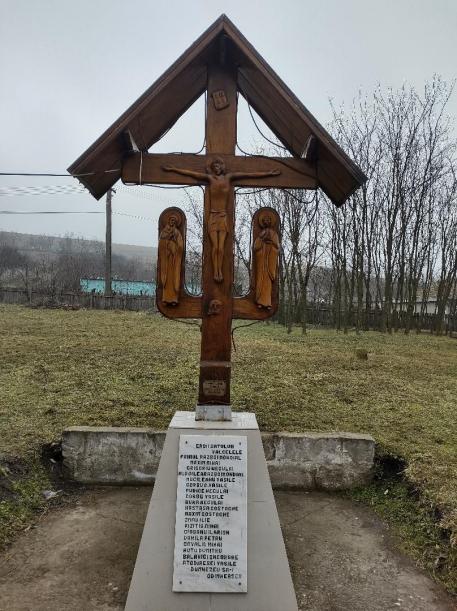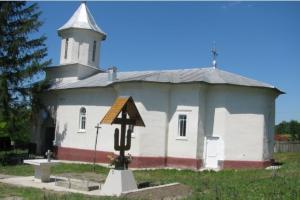The town of Vâlcelele[1] is located in Vlădeni commune, Iaşi county, approximately 5 km from the village of Vlădeni and 40 km from the county seat. Located on the valley of the Harbarău stream, a tributary of the Jijia, the village covers approximately 55 ha.
The oldest mentions of the village of Vâlcelele (formerly Găureni) appear at the beginning of the 17th century, but there is little information, the village being more of a hamlet. We find some important data about the same locality, especially with the beginning of the 19th century. Thus, the village is mentioned in 1803, on the estate of the nobleman Iordache Gheucă, as having 13 inhabitants. Over 17 years, 26 residents are mentioned, the Găureni estate now being owned by the glassmaker Neculai Dimitriu. Now the first ministers of the wooden church in this village are mentioned, the priest Ion and the teacher Dumitru. According to the information preserved from this period, the village church was built from oak beams between 1819-1821. In the year of Tudor Vladimirescu's revolution, the small place of worship was consecrated. Synod no. 341 of 1874 mentions that the wooden church "was made and decorated with everything necessary by the blessed founder Vasile Stroescu with the patron saint of the Assumption".
[1] Following decree no. 799 of December 17, 1964 regarding the change of the name of some localities, published in the Official Gazette no. 20 of December 18, 1964, starting from January 1, 1965, the name of the village of Găureni (Vlădeni commune, Iaşi county) is changed to Vâlcelele.
We have another mention of the village in 1832, now the estate had 45 inhabitants and belonged to the cupmaker Necula Gheucă. The priest of the village church was Ion sin Pavel, and the teacher Vasile sin Roşca. Over 20 years, the village had the same number of inhabitants, the priest being Toader, and the teacher Ion. Now the estate is owned by Gheorghe Stroja.
We mention that the Geographical Dictionary of Romania attests to the existence of the village of Găureni in 1898, which had a church made of oak beams and 54 inhabitants. The church was a subsidiary of Borşa parish (the neighboring village with a larger number of inhabitants), Roşcani commune.
The historical mentions about the village and its little church diminish after this period. But there is certainty that the little church made of oak beams lasted until after the Second World War, near the current place of worship. The elders of the village still remember its existence today.
In the interwar period, the problem of building a new, more permanent church was raised, probably also due to the fact that the wooden church had either become too spacious or had been degraded by the passage of the front (from the First World War) through the area. The desire of the inhabitants of the village, which now numbered approximately 100 souls, materialized starting in 1927, the year in which the gathering of the material and funds necessary for the construction of the new place of worship, near the old wooden church, began. Among those who fought for the fulfillment of this desire, we mention the priest Alexandru Popovici[1], the teacher Constantin Gheorghiu and Ion I Macovei (cashier). On July 13, 1937, the foundation stone for the new church was laid, and in September of the same year it was completed. The church was built of river stone and brick, with an octagonal bell tower above the porch. It is covered with tin and has the shape of a cross, with two lateral apses on the nave and one on the altar. The architect Aurel Ghelmette was the supervisor and responsible for the construction of this religious edifice.
Although the works on this place of worship were completed since the fall of 1937, the first religious services were held here only in 1946, this and due to the Second World War which directly affected the area where it is located where the town is located. Two years after the end of the second world conflagration, the church was consecrated with a great council of priests. But the vicissitudes of history meant that religious services were held in the new place of worship only until 1949, when the communist regime installed at the head of the country forbade the celebration of the Holy Liturgy in the village church.
In the second half of the 20th century, the priests Nicolae Maxim and Iancu Grigoraş were found for the Borşa parish and its Găureni branch. The first will replace the founder of the church in the village of Găureni in 1937 and will remain in this area until 1939, when he will retire to his native village of Perieni. The second priest came by transfer from the Ciurbeşti parish (near the city of Iasi) and will serve in the two parishes until January 1973, when he is retired[2].
In March of 1973, Father Vasile Cîrdei was appointed parish priest in Borşa and Găureni. His installation took place on April 23, 1973. His pastorate is of particular importance for the village of Vâlcelele (Găureni), because during this period the restoration works of the church began. The place of worship was consolidated on the outside and inside. Inside, the church was endowed with a new carved pediment, made of oak wood, with liturgical books, a Holy Gospel and Holy Vessels.
The village church was consecrated and returned to worship in 1975. The re-consecration service of the place of worship was officiated by the Most Reverend Bishop Adrian Hriscu, then Vicar Bishop of the Metropolitanate of Moldova.
From this period until 2002, Vâlcele Parish was a subsidiary of Borşa Parish. In 2002, Blessed Daniel, the Patriarch of the Romanian Orthodox Church, then Metropolitan of Moldova and Bucovina, named this independent branch, becoming a parish. Between 1973 and 2015, Vâlcele Parish was shepherded by three priests: Father Vasile Cârdei (1973-2003), Father Marian Slabu (2003-2006) and Father Cătălin Adumitroaie (July 2006 - August 2015).
In 2015, on August 26, priest Claudiu Ciobanu was installed in the parish, who still serves today.
[1] Father Alexandru Popovici was born in 1861, graduated from the Lower Seminary and was appointed priest in the villages of Borşa and Găureni (Vâlcelele) on May 29, 1888. He remained in this position until the end of 1937, when after 49 years of shepherding retires.
[2] From the work of Vasile Manea, Orthodox priests in communist prisons, Ed. Patmos, Cluj-Napoca, 2010, p. 156, we learn that "Priest Iancu Grigoraş from Borşa, Iasi, went through communist prisons, according to the testimony of Father Alexandru D. Anton". He most likely suffered during this period because he was the head of a legionary nest in this area.










